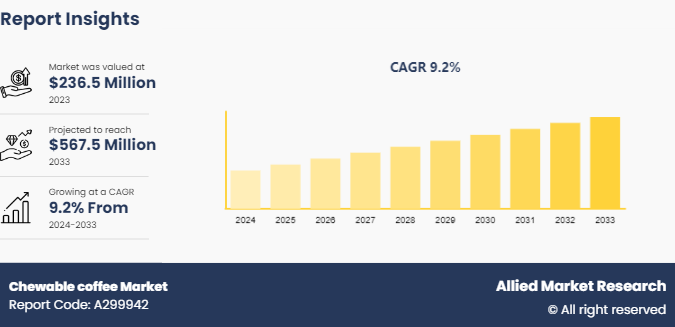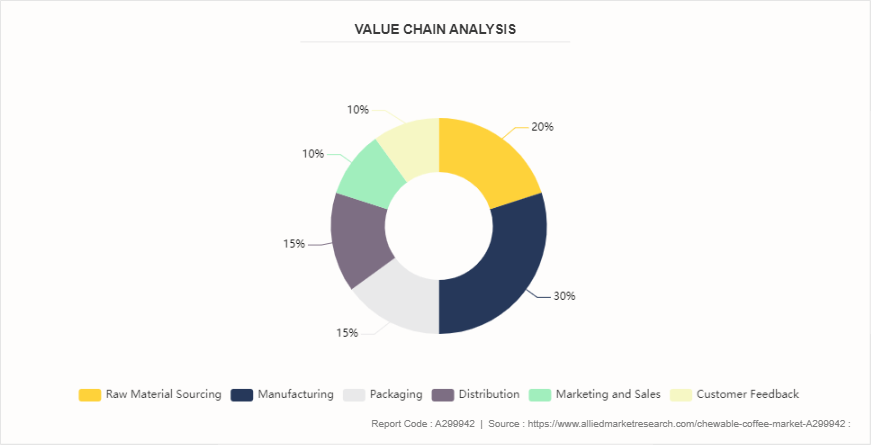Chewable coffee Market
P
2024
Chewable coffee Market Size, Share, Competitive Landscape and Trend Analysis Report, by Product Type, by Distribution Channel : Global Opportunity Analysis and Industry Forecast, 2024-2033
Chewable Coffee Market Research, 2033
Market Introduction and Definition
The global chewable coffee market size was valued at $236.5 million in 2023 and is projected to reach $567.5 million by 2033, growing at a CAGR of 9.2% from 2024 to 2033. Chewable coffee is an innovative product that delivers the caffeine and flavor of coffee in a convenient, solid form. It typically comes as a small, flavored chew or gummy, offering a portable and quick alternative to traditional coffee beverages. This market exists to cater to busy individuals seeking a rapid energy boost without the need to brew coffee or consume a hot beverage. Key benefits include convenience, as it eliminates the preparation time and mess associated with liquid coffee, and portability, making it ideal for on-the-go consumption. Additionally, chewable coffee provides a controlled dose of caffeine, reducing the risk of overconsumption and allowing for more precise energy management. The rise in demand for quick and efficient caffeine sources has fueled the growth of this market, aligning with the fast-paced lifestyle of modern consumers.

Key Takeaways
-
The chewable coffee market study covers 20 countries. The research includes a segment analysis of each country in terms of value ($million) for the forecast period 2024-2033.
-
More than 1, 500 product literatures, industry releases, annual reports, and other such documents of major chewable coffee industry participants along with authentic industry journals, trade associations' releases, and government websites have been reviewed for generating high-value industry insights.
-
The study integrated high-quality data, professional opinions and analysis, and critical independent perspectives. The research approach is intended to provide a balanced view of global markets and assist stakeholders in making educated decisions to achieve their most ambitious growth objectives.
Key Market Dynamics
-
The fast-paced lifestyles of modern consumers drive the demand for convenient energy solutions. Chewable coffee offers a quick, portable alternative to traditional coffee, appealing to individuals who need an energy boost without the hassle of brewing or the risk of spills. This convenience factor is particularly attractive to busy professionals, students, and travelers, making it a significant growth driver for the market. As more people seek easy and efficient ways to stay energized, the chewable coffee market continues to expand.
-
The growing awareness of health and wellness is pushing consumers to seek out healthier caffeine options. Chewable coffee products often contain natural ingredients and vitamins, positioning themselves as a healthier alternative to sugary energy drinks and traditional coffee laden with cream and sugar. This alignment with health trends attracts health-conscious consumers looking for a cleaner energy source, driving market growth. Companies that emphasize their products' health benefits and natural ingredients are particularly well-positioned to capture this expanding segment in the chewable coffee market forecast.
-
Continuous innovation in chewable coffee products is a key growth driver. Companies are developing new flavors, adding functional ingredients like nootropics and vitamins, and improving texture and taste to enhance the consumer experience. These innovations attract a broader audience, from health enthusiasts to tech-savvy individuals looking for enhanced cognitive performance. By constantly evolving their offerings and meeting diverse consumer preferences, chewable coffee brands can maintain consumer interest and drive chewable coffee market growth, ensuring a steady influx of new customers.
Value Chain Analysis
The value chain of the chewable coffee market includes various stakeholders’ raw material, manufacturers, Packaging, distributors, marketing and sales, and customer feedback. Each of these players adds a specific value at their point of operation, which, in turn, contributes to the competitive value of the product.
Raw Material Sourcing: This stage involves procuring high-quality ingredients essential for producing chewable coffee, such as coffee extract, sweeteners, flavorings, and functional additives like vitamins or nootropics. Sourcing sustainable and ethically produced raw materials can enhance brand reputation and appeal to eco-conscious consumers.
Manufacturing: In this stage, raw materials are processed and formulated into chewable coffee products. This includes blending the ingredients, forming the chews or gummies, and ensuring consistency and quality. Advanced manufacturing techniques and quality control measures are vital to maintaining product standards and meeting regulatory requirements.
Packaging: Packaging plays a critical role in protecting the product, extending its shelf life, and providing convenience to consumers. Innovative and eco-friendly packaging solutions can also differentiate a brand in the market. This stage involves designing and producing packaging that is both functional and appealing, often incorporating recyclable or biodegradable materials.
Distribution: Effective distribution ensures that chewable coffee products reach various retail channels, including supermarkets, specialty stores, online platforms, and vending machines. Efficient logistics and supply chain management are essential to maintain product availability and meet consumer demand across different regions.
Marketing and Sales: This stage involves creating awareness and generating demand for chewable coffee through targeted marketing campaigns, social media engagement, influencer partnerships, and promotional activities. Sales strategies may include in-store promotions, online discounts, and subscription models to attract and retain customers.
Customer Feedback: Collecting and analyzing customer feedback is crucial for continuous improvement. This stage involves monitoring reviews, conducting surveys, and engaging with consumers on social media to understand their preferences and address any concerns. Insights gained from feedback help refine products, improve customer satisfaction, and drive future innovations.

Market Segmentation
The chewable coffee market is segmented into product type, distribution channel, and region. By product type, the chewable coffee market is divided into caffeine gummies, caffeine chews, caffeine tablets, and others. By distribution channel, the market is segregated into hypermarkets & supermarkets, specialty stores, convenience stores, online retailers, and others. Region wise, the market is analyzed across North America, Europe, Asia-Pacific, Latin America, Middle East, and Africa.
Regional Market Outlook
North America held the major chewable coffee market share in 2023. With busy lifestyles and a high reliance on quick energy boosts, consumers are seeking alternatives to traditional coffee that fit seamlessly into their routines. Chewable coffee provides a compact, mess-free option that can be consumed anytime and anywhere, appealing particularly to professionals, students, and travelers. This convenience factor, coupled with the rising trend of on-the-go snacking and the need for efficient caffeine delivery, significantly propels the growth of the chewable coffee market in North America. ???????
Industry Trends
-
As more consumers prioritize health, chewable coffee companies are innovating by using natural ingredients and avoiding artificial additives. For example, Viter Energy has launched chewable coffee products fortified with vitamins B6 and B12, appealing to health-conscious individuals looking for a healthier energy boost.
-
Moreover, there is a rise in demand for functional foods that offer additional benefits beyond basic nutrition. HVMN has introduced chewable coffee with added nootropics, targeting consumers interested in enhanced cognitive function and mental clarity, thus meeting the demand for multifunctional products.
-
With busy lifestyles, consumers seek convenient energy solutions. Dry Brew has capitalized on this by offering chewable coffee cubes that provide a quick, portable caffeine fix, ideal for people on the go, such as commuters and travelers, making it easier to get an energy boost without the need for brewing equipment.
Competitive Landscape
-
The major players operating in the chewable coffee market include Viter Energy, Go Cubes by Nootrobox, Java Me Up, Kaffn8, Dry Brew, HVMN (Health Via Modern Nutrition) , Verb Energy, Stay Buzzed, and Hector Beverages.
Key Benefits For Stakeholders
- This report provides a quantitative analysis of the market segments, current trends, estimations, and dynamics of the chewable coffee market analysis from 2024 to 2033 to identify the prevailing chewable coffee market opportunities.
- The market research is offered along with information related to key drivers, restraints, and opportunities.
- Porter's five forces analysis highlights the potency of buyers and suppliers to enable stakeholders make profit-oriented business decisions and strengthen their supplier-buyer network.
- In-depth analysis of the chewable coffee market segmentation assists to determine the prevailing market opportunities.
- Major countries in each region are mapped according to their revenue contribution to the global market.
- Market player positioning facilitates benchmarking and provides a clear understanding of the present position of the market players.
- The report includes the analysis of the regional as well as global chewable coffee market trends, key players, market segments, application areas, and market growth strategies.
Chewable coffee Market Report Highlights
| Aspect | Details |
|---|---|
Market Size By 2033 | USD 567.5 Million |
Growth Rate | CAGR of 9.2% |
Forecast period | 2024 - 2033 |
Report Pages | 210 |
By Product Type |
|
By Distribution Channel |
|
By Region |
|
Key Market Players | Viter Energy, Dry Brew, Java Me Up, Hector Beverages, HVMN, Verb Energy, Kaffn8, Stay Buzzed, Go Cubes by Nootrobox |
Related Tags
Caffeine Gummies Caffeine Chews Caffeine Tablets Chewable CoffeeFrequently Asked Questions?
The chewable coffee market was valued at $236.5 million in 2023 and is estimated to reach $567.5 million by 2033, exhibiting a CAGR of 9.2% from 2024 to 2033.
The chewable coffee market is segmented into product type, distribution channel, and region. By product type, the chewable coffee market is divided into caffeine gummies, caffeine chews, caffeine tablets, and others. By distribution channel, the market is segregated into hypermarkets & supermarkets, specialty stores, convenience stores, online retailers, and others. Region wise, the market is analyzed across North America, Europe, Asia-Pacific, Latin America, Middle East, and Africa.
North America is the largest regional market for chewable coffee
The major players operating in the chewable coffee market include Viter Energy, Go Cubes by Nootrobox, Java Me Up, Kaffn8, Dry Brew, HVMN (Health Via Modern Nutrition), Verb Energy, Stay Buzzed, and Hector Beverages.
The global chewable coffee market report is available on request on the website of Allied Market Research.

